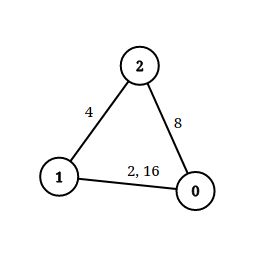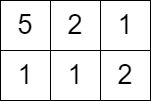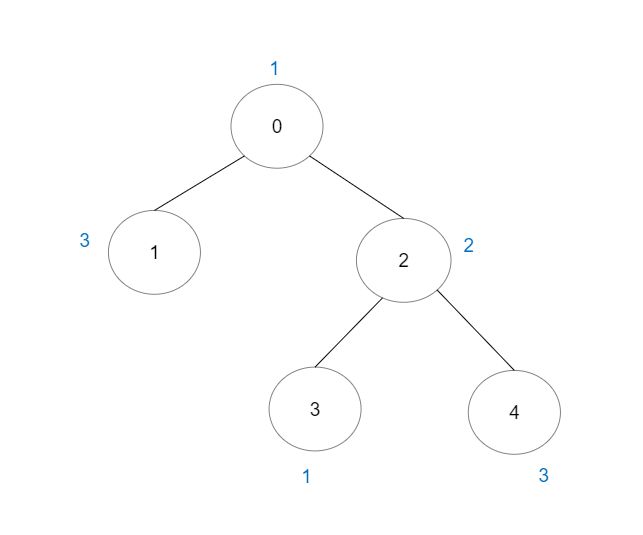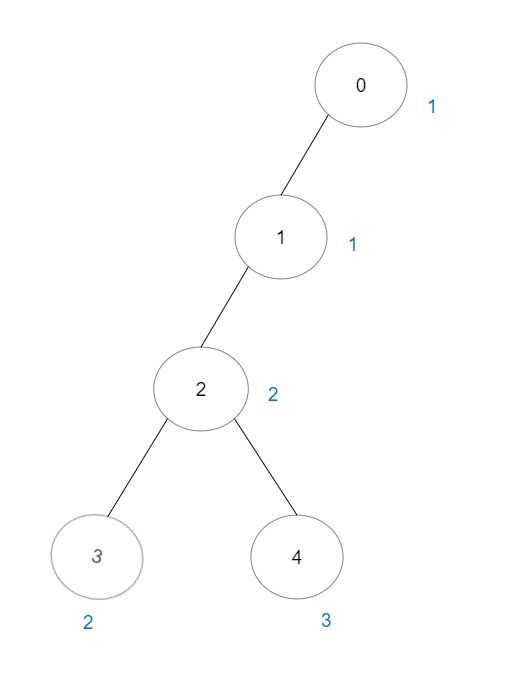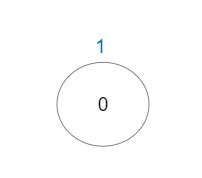并查集、并查集+离线、并查集+倒叙回答
文章目录
- 并查集
-
- [200. 岛屿数量](https://leetcode.cn/problems/number-of-islands/)
- [721. 账户合并](https://leetcode.cn/problems/accounts-merge/)
- 并查集 + 离线计算
-
- [1697. 检查边长度限制的路径是否存在](https://leetcode.cn/problems/checking-existence-of-edge-length-limited-paths/)
- [2503. 矩阵查询可获得的最大分数](https://leetcode.cn/problems/maximum-number-of-points-from-grid-queries/)
- 并查集 + 倒序回答
-
- [2382. 删除操作后的最大子段和](https://leetcode.cn/problems/maximum-segment-sum-after-removals/)
- [2421. 好路径的数目](https://leetcode.cn/problems/number-of-good-paths/)
并查集
并查集模板:
class UnionFind {
//par数组用来存储根节点,par[x]=y表示x的根节点为y
private int[] parent;
public UnionFind(int n) {
parent = new int[n];
//初始化, 每个节点都是一个联通分量
for (int i = 0; i < n; i++) {
parent[i] = i;
}
}
//查找x所在集合的根(带路径压缩)
private int find(int x) {
if (x != parent[x]) {
//递归返回的同时压缩路径
parent[x] = find(parent[x]);
}
return parent[x];
}
//合并x与y所在集合
public void union(int x, int y) {
int xRoot = find(x);
int yRoot = find(y);
if (xRoot != yRoot) { //不是同一个根,即不在同一个集合,就合并
parent[xRoot] = yRoot;
}
}
}
//
class UnionFind {
// 用 Map 在存储并查集,表达的含义是 key 的父节点是 value
private Map<Integer,Integer> father;
// 0.构造函数初始化,初始时各自为一个集合,用null来表示
public UnionFind(int n) {
father = new HashMap<Integer,Integer>();
for (int i = 0; i < n; i++) {
father.put(i, null);//或者father.put(i,i);
}
}
// 1.添加:初始加入时,每个元素都是一个独立的集合,因此
public void add(int x) { // 根节点的父节点为null
if (!father.containsKey(x)) {
father.put(x, null);//或者father.put(x,x); 根节点的父节点为自己
}
}
// 2.查找:反复查找父亲节点。
public int find(int x) {
int root = x; // 寻找x祖先节点保存到root中
while(father.get(root) != null){//或者father.get(root) != root
root = father.get(root);
}
while(x != root){ // 路径压缩,把x到root上所有节点都挂到root下面
int original_father = father.get(x); // 保存原来的父节点
father.put(x,root); // 当前节点挂到根节点下面
x = original_father; // x赋值为原来的父节点继续执行刚刚的操作
}
return root;
}
// 3.合并:把两个集合合并为一个,只需要把其中一个集合的根节点挂到另一个集合的根节点下方
//也可以记录两个集合的大小,根据大小将小集合父节点挂载到大集合父节点上
public void union(int x, int y) { // x的集合和y的集合合并
int rootX = find(x);
int rootY = find(y);
if (rootX != rootY){ // 节点联通只需要一个共同祖先,无所谓谁是根节点
father.put(rootX,rootY);
}
}
// 4.判断:判断两个元素是否同属一个集合
public boolean isConnected(int x, int y) {
return find(x) == find(y);
}
}
200. 岛屿数量
难度中等2119
给你一个由 '1'(陆地)和 '0'(水)组成的的二维网格,请你计算网格中岛屿的数量。
岛屿总是被水包围,并且每座岛屿只能由水平方向和/或竖直方向上相邻的陆地连接形成。
此外,你可以假设该网格的四条边均被水包围。
示例 1:
输入:grid = [
["1","1","1","1","0"],
["1","1","0","1","0"],
["1","1","0","0","0"],
["0","0","0","0","0"]
]
输出:1
示例 2:
输入:grid = [
["1","1","0","0","0"],
["1","1","0","0","0"],
["0","0","1","0","0"],
["0","0","0","1","1"]
]
输出:3
提示:
m == grid.lengthn == grid[i].length1 <= m, n <= 300grid[i][j]的值为'0'或'1'
题解:https://leetcode.cn/problems/number-of-islands/solution/dfs-bfs-bing-cha-ji-python-dai-ma-java-dai-ma-by-l/
并查集中维护连通分量的个数,在遍历的过程中:
-
相邻的陆地(只需要向右看和向下看)合并,只要发生过合并,岛屿的数量就减少
-
在遍历的过程中,同时记录空地的数量;
-
并查集中连通分量的个数 - 空地的个数,就是岛屿数量。
class Solution {
int rows, cols;
public int numIslands(char[][] grid) {
rows = grid.length;
if(rows == 0) return 0;
cols = grid[0].length;
int space = 0; // 空地的数量
UnionFind unionFind = new UnionFind(rows * cols);
int[][] directions = {{1, 0}, {0, 1}};
for(int i = 0; i < rows; i++){
for(int j = 0; j < cols; j++){
if(grid[i][j] == '0'){
space++;
continue;
}
for(int[] dir : directions){
int newx = i + dir[0];
int newy = j + dir[1];
if(newx < rows && newy < cols && grid[newx][newy] == '1'){
unionFind.union(getIndex(i, j), getIndex(newx, newy));
}
}
}
}
// 并查集中连通分量的个数 - 空地的个数,就是岛屿数量
return unionFind.getCount() - space;
}
private int getIndex(int i, int j) {
return i * cols + j;
}
}
class UnionFind {
//par数组用来存储根节点,par[x]=y表示x的根节点为y
private int[] parent;
private int count;
public int getCount(){
return count;
}
public UnionFind(int n) {
parent = new int[n];
this.count = n;
//初始化, 每个节点都是一个联通分量
for (int i = 0; i < n; i++) {
parent[i] = i;
}
}
//查找x所在集合的根(带路径压缩)
private int find(int x) {
if (x != parent[x]) {
//递归返回的同时压缩路径
parent[x] = find(parent[x]);
}
return parent[x];
}
//合并x与y所在集合
public void union(int x, int y) {
int xRoot = find(x);
int yRoot = find(y);
if (xRoot != yRoot) { //不是同一个根,即不在同一个集合,就合并
parent[xRoot] = yRoot;
count--;
}
}
}
721. 账户合并
难度中等428
给定一个列表 accounts,每个元素 accounts[i] 是一个字符串列表,其中第一个元素 accounts[i][0] 是 名称 (name),其余元素是 emails 表示该账户的邮箱地址。
现在,我们想合并这些账户。如果两个账户都有一些共同的邮箱地址,则两个账户必定属于同一个人。请注意,即使两个账户具有相同的名称,它们也可能属于不同的人,因为人们可能具有相同的名称。一个人最初可以拥有任意数量的账户,但其所有账户都具有相同的名称。
合并账户后,按以下格式返回账户:每个账户的第一个元素是名称,其余元素是 按字符 ASCII 顺序排列 的邮箱地址。账户本身可以以 任意顺序 返回。
示例 1:
输入:accounts = [["John", "[email protected]", "[email protected]"], ["John", "[email protected]"], ["John", "[email protected]", "[email protected]"], ["Mary", "[email protected]"]]
输出:[["John", '[email protected]', '[email protected]', '[email protected]'], ["John", "[email protected]"], ["Mary", "[email protected]"]]
解释:
第一个和第三个 John 是同一个人,因为他们有共同的邮箱地址 "[email protected]"。
第二个 John 和 Mary 是不同的人,因为他们的邮箱地址没有被其他帐户使用。
可以以任何顺序返回这些列表,例如答案 [['Mary','[email protected]'],['John','[email protected]'],
['John','[email protected]','[email protected]','[email protected]']] 也是正确的。
示例 2:
输入:accounts = [["Gabe","[email protected]","[email protected]","[email protected]"],["Kevin","[email protected]","[email protected]","[email protected]"],["Ethan","[email protected]","[email protected]","[email protected]"],["Hanzo","[email protected]","[email protected]","[email protected]"],["Fern","[email protected]","[email protected]","[email protected]"]]
输出:[["Ethan","[email protected]","[email protected]","[email protected]"],["Gabe","[email protected]","[email protected]","[email protected]"],["Hanzo","[email protected]","[email protected]","[email protected]"],["Kevin","[email protected]","[email protected]","[email protected]"],["Fern","[email protected]","[email protected]","[email protected]"]]
提示:
1 <= accounts.length <= 10002 <= accounts[i].length <= 101 <= accounts[i][j].length <= 30accounts[i][0]由英文字母组成accounts[i][j] (for j > 0)是有效的邮箱地址
class Solution {
// 利用一个字符串的映射存储并查集
Map<String, String> map;
public List<List<String>> accountsMerge(List<List<String>> accounts) {
map = new HashMap<>();
// 这个映射存储每个邮箱对应账户的名字
Map<String, String> names = new HashMap<>();
// 遍历所有账户构建并查集
for(List<String> a : accounts){
for(int i = 1; i < a.size(); i++){
if(!map.containsKey(a.get(i))){
// 如果并查集中没有这个邮箱,则添加邮箱,其根元素就是本身
map.put(a.get(i), a.get(i));
// 添加该邮箱对应的账户名
names.put(a.get(i), a.get(0));
}
if(i > 1){
// 并查集的合并操作,合并一个账户中的所有邮箱
map.put(find(a.get(i)), find(a.get(i-1)));
}
}
}
// 暂时存储答案中的邮箱列表,每个键值对的键就是每个并查集集合的根元素
Map<String, List<String>> temp = new HashMap<>();
for(String email : map.keySet()){
// 获取当前邮箱对应并查集的根元素
String root = find(email);
// 将当前邮箱放入根元素对应的列表中
if(!temp.containsKey(root)) temp.put(root, new ArrayList<>());
temp.get(root).add(email);
}
List<List<String>> res = new ArrayList();
// 将答案从映射中放到列表中
for(String root : temp.keySet()){
// 获取当前根元素对应的列表
List<String> layer = temp.get(root);
// 题目要求的排序
Collections.sort(layer);
// 添加姓名
layer.add(0, names.get(root));
// 将当前列表加入答案
res.add(layer);
}
return res;
}
// 并查集查找模板函数,这里用字符串替换了之前的整型
String find(String x){
if(!map.get(x).equals(x)){
map.put(x, find(map.get(x)));
}
return map.get(x);
}
}
并查集 + 离线计算
**离线算法其实就是将多个询问一次性解决。**离线算法往往是与在线算法相对的。
https://www.zhihu.com/question/31540121/answer/1771748651
**离线计算:算法在求解问题时已具有与该问题相关的完全信息,通常将这类具有问题完全信息的前提下设计出的算法称为离线算法(off line algorithms)。**对于实际情况来说,情况往往不同,许多问题以在线(on line)的方式给出算法所需的数据,例如磁盘调度问题中,用户对磁盘的访问请求是无法预知的,它是随着时间的推移一个接着一个地给出的。这类在线问题设计的算法就称为在线算法。
1697. 检查边长度限制的路径是否存在
难度困难163
给你一个 n 个点组成的无向图边集 edgeList ,其中 edgeList[i] = [ui, vi, disi] 表示点 ui 和点 vi 之间有一条长度为 disi 的边。请注意,两个点之间可能有 超过一条边 。
给你一个查询数组queries ,其中 queries[j] = [pj, qj, limitj] ,你的任务是对于每个查询 queries[j] ,判断是否存在从 pj 到 qj 的路径,且这条路径上的每一条边都 严格小于 limitj 。
请你返回一个 布尔数组 answer ,其中 answer.length == queries.length ,当 queries[j] 的查询结果为 true 时, answer 第 j 个值为 true ,否则为 false 。
示例 1:
输入:n = 3, edgeList = [[0,1,2],[1,2,4],[2,0,8],[1,0,16]], queries = [[0,1,2],[0,2,5]]
输出:[false,true]
解释:上图为给定的输入数据。注意到 0 和 1 之间有两条重边,分别为 2 和 16 。
对于第一个查询,0 和 1 之间没有小于 2 的边,所以我们返回 false 。
对于第二个查询,有一条路径(0 -> 1 -> 2)两条边都小于 5 ,所以这个查询我们返回 true 。
示例 2:
输入:n = 5, edgeList = [[0,1,10],[1,2,5],[2,3,9],[3,4,13]], queries = [[0,4,14],[1,4,13]]
输出:[true,false]
解释:上图为给定数据。
提示:
2 <= n <= 1051 <= edgeList.length, queries.length <= 105edgeList[i].length == 3queries[j].length == 30 <= ui, vi, pj, qj <= n - 1ui != vipj != qj1 <= disi, limitj <= 109- 两个点之间可能有 多条 边。
class Solution {
// 题意:给n个节点m条带权值边的无向图。然后q个问题,每次询问点对的数目,
// 点对需要满足的条件是:1)连通;2)其路径的最大权值不能超过询问值limit。
// 分析:如果每次询问一次,dfs一次,很可能超时,因此可以用并查集。
// 离线处理,把边按权值排序,把问题按大小排序。然后离线的过程就是不断向图中加边的过程。
int[] parent; // 并查集
public boolean[] distanceLimitedPathsExist(int n, int[][] edgeList, int[][] queries) {
parent = new int[n + 5];
int m = queries.length, o = edgeList.length;
// 初始化并查集
for(int i = 0; i < n; i++) parent[i] = i;
for(int i = 0; i < m; i++){
// 由于需要将问题按大小排序,最后返回需要按序返回,所以需要将下表zip起来
queries[i] = new int[]{i, queries[i][0], queries[i][1], queries[i][2]};
}
Arrays.sort(edgeList, (a, b) -> a[2] - b[2]);// 边按权值从小到大排序
Arrays.sort(queries, (a, b) -> a[3] - b[3]); // 问题按询问从小到大排序
boolean[] ans = new boolean[m];
for(int i = 0, j = 0; i < m; i++){
// 离线,将边长度小于查询limit的边都合并起来
while(j < o && edgeList[j][2] < queries[i][3]){
union(edgeList[j][0], edgeList[j][1]);
j++;
}
// 查看两个点是否在同一个联通块上
int a = find(parent[queries[i][1]]);
int b = find(parent[queries[i][2]]);
ans[queries[i][0]] = a == b;
}
return ans;
}
public void union(int a, int b){
int x = find(a);
int y = find(b);
parent[y] = x;
}
public int find(int x){
if(x != parent[x]) parent[x] = find(parent[x]);
return parent[x];
}
}
2503. 矩阵查询可获得的最大分数
难度困难33
给你一个大小为 m x n 的整数矩阵 grid 和一个大小为 k 的数组 queries 。
找出一个大小为 k 的数组 answer ,且满足对于每个整数 queres[i] ,你从矩阵 左上角 单元格开始,重复以下过程:
- 如果
queries[i]严格 大于你当前所处位置单元格,如果该单元格是第一次访问,则获得 1 分,并且你可以移动到所有4个方向(上、下、左、右)上任一 相邻 单元格。 - 否则,你不能获得任何分,并且结束这一过程。
在过程结束后,answer[i] 是你可以获得的最大分数。注意,对于每个查询,你可以访问同一个单元格 多次 。
返回结果数组 answer 。
示例 1:
输入:grid = [[1,2,3],[2,5,7],[3,5,1]], queries = [5,6,2]
输出:[5,8,1]
解释:上图展示了每个查询中访问并获得分数的单元格。
示例 2:
输入:grid = [[5,2,1],[1,1,2]], queries = [3]
输出:[0]
解释:无法获得分数,因为左上角单元格的值大于等于 3 。
提示:
m == grid.lengthn == grid[i].length2 <= m, n <= 10004 <= m * n <= 105k == queries.length1 <= k <= 1041 <= grid[i][j], queries[i] <= 106
题解:https://leetcode.cn/problems/maximum-number-of-points-from-grid-queries/solution/by-endlesscheng-qeei/
把矩阵的元素值从小到大排序,询问也从小到大排序。
用双指针遍历矩阵元素值和询问,如果矩阵元素值小于询问值,就把该格子和周围四个格子中的小于询问值的格子相连。
用并查集可以实现相连的过程,同时维护每个连通块的大小。
答案就是左上角的连通块的大小(前提是左上角小于询问值)。
class Solution {
private static final int[][] dirs = {{-1, 0}, {0, 1}, {0, -1}, {1,0}};
private int[] parent,size;
public int[] maxPoints(int[][] grid, int[] queries) {
int m = grid.length, n = grid[0].length, mn = m * n;
// 并查集初始化
parent = new int[mn];
for(int i = 0; i < mn; i++) parent[i] = i;
size = new int[mn];
Arrays.fill(size, 1);
// 矩阵元素从小到大排序,方便离线查询
int[][] a = new int[mn][3];
for(int i = 0; i < m; i++){
for(int j = 0; j < n; j++){
a[i*n + j] = new int[]{grid[i][j], i, j};
}
}
Arrays.sort(a, (p, q) -> p[0] - q[0]);
// 查询的下标按照查询值从小到大排序,方便离线
int k = queries.length;
Integer[] id = IntStream.range(0, k).boxed().toArray(Integer[]::new);
Arrays.sort(id, (i, j) -> queries[i] - queries[j]);
int[] ans = new int[k];
int j = 0;
for(int i : id){
int q = queries[i]; // 限定值limit
while(j < mn && a[j][0] < q){
int x = a[j][1], y = a[j][2];
//将(x,y)点与四个格子连接起来,前提是符合条件
for(int[] d : dirs){
int nx = x + d[0], ny = y + d[1];
if(0 <= nx && nx < m && 0 <= ny && ny < n && grid[nx][ny] < q){
union(x*n + y, nx*n + ny);// 把坐标压缩成一维的编号
}
}
j++;
}
if(grid[0][0] < q){
ans[i] = size[find(0)];// 左上角的连通块的大小
}
}
return ans;
}
private void union(int x, int y){
int a = find(x);
int b = find(y);
if(a != b){
parent[b] = a;
size[a] += size[b];
}
}
private int find(int x){
if(x != parent[x]) parent[x] = find(parent[x]);
return parent[x];
}
}
并查集 + 倒序回答
倒序回答:删除不好做,添加比较好做。不妨倒着思考,删除变成了添加。
相似题目:
- 2334. 元素值大于变化阈值的子数组
- 1562. 查找大小为 M 的最新分组
2382. 删除操作后的最大子段和
难度困难23
给你两个下标从 0 开始的整数数组 nums 和 removeQueries ,两者长度都为 n 。对于第 i 个查询,nums 中位于下标 removeQueries[i] 处的元素被删除,将 nums 分割成更小的子段。
一个 子段 是 nums 中连续 正 整数形成的序列。子段和 是子段中所有元素的和。
请你返回一个长度为 n 的整数数组 answer ,其中 answer[i]是第 i 次删除操作以后的 最大 子段和。
**注意:**一个下标至多只会被删除一次。
示例 1:
输入:nums = [1,2,5,6,1], removeQueries = [0,3,2,4,1]
输出:[14,7,2,2,0]
解释:用 0 表示被删除的元素,答案如下所示:
查询 1 :删除第 0 个元素,nums 变成 [0,2,5,6,1] ,最大子段和为子段 [2,5,6,1] 的和 14 。
查询 2 :删除第 3 个元素,nums 变成 [0,2,5,0,1] ,最大子段和为子段 [2,5] 的和 7 。
查询 3 :删除第 2 个元素,nums 变成 [0,2,0,0,1] ,最大子段和为子段 [2] 的和 2 。
查询 4 :删除第 4 个元素,nums 变成 [0,2,0,0,0] ,最大子段和为子段 [2] 的和 2 。
查询 5 :删除第 1 个元素,nums 变成 [0,0,0,0,0] ,最大子段和为 0 ,因为没有任何子段存在。
所以,我们返回 [14,7,2,2,0] 。
示例 2:
输入:nums = [3,2,11,1], removeQueries = [3,2,1,0]
输出:[16,5,3,0]
解释:用 0 表示被删除的元素,答案如下所示:
查询 1 :删除第 3 个元素,nums 变成 [3,2,11,0] ,最大子段和为子段 [3,2,11] 的和 16 。
查询 2 :删除第 2 个元素,nums 变成 [3,2,0,0] ,最大子段和为子段 [3,2] 的和 5 。
查询 3 :删除第 1 个元素,nums 变成 [3,0,0,0] ,最大子段和为子段 [3] 的和 3 。
查询 5 :删除第 0 个元素,nums 变成 [0,0,0,0] ,最大子段和为 0 ,因为没有任何子段存在。
所以,我们返回 [16,5,3,0] 。
提示:
n == nums.length == removeQueries.length1 <= n <= 1051 <= nums[i] <= 1090 <= removeQueries[i] < nremoveQueries中所有数字 互不相同 。
题解:https://leetcode.cn/problems/maximum-segment-sum-after-removals/solution/by-endlesscheng-p61j/
删除不好做,添加比较好做。不妨倒着思考,删除变成了添加。
添加时可能会合并两个子段。我们需要考虑如何动态维护每个子段的元素和,并高效地合并两个子段。
class Solution {
//为什么不需要连接x,x-1?
//合并都是往右合并的 x的结果会保留在x+1 就相当于已经合并了左边
//ans[i] 要么取上一个ans[i+1] 的最大子段和,要么取合并后的子段和,这两者取最大值。
int[] parent;
public long[] maximumSegmentSum(int[] nums, int[] removeQueries) {
int n = removeQueries.length;
parent = new int[n+1];
for(int i = 0; i <= n; i++) parent[i] = i;
long[] sum = new long[n+1];
long[] ans = new long[n];
ans[n-1] = 0;
for(int i = n-1; i > 0; i--){
int idx = removeQueries[i]; // 添加的下标idx
union(idx, idx+1);
int to = parent[idx];
sum[to] += nums[idx] + sum[idx];
ans[i-1] = Math.max(sum[to], ans[i]);
}
return ans;
}
public void union(int a, int b){
int x = find(a);
int y = find(b);
if(x != y){
parent[x] = y;
}
}
public int find(int x){
if(x != parent[x]) parent[x] = find(parent[x]);
return parent[x];
}
}
2421. 好路径的数目
难度困难68
给你一棵 n 个节点的树(连通无向无环的图),节点编号从 0 到 n - 1 且恰好有 n - 1 条边。
给你一个长度为 n 下标从 0 开始的整数数组 vals ,分别表示每个节点的值。同时给你一个二维整数数组 edges ,其中 edges[i] = [ai, bi] 表示节点 ai 和 bi 之间有一条 无向 边。
一条 好路径 需要满足以下条件:
- 开始节点和结束节点的值 相同 。
- 开始节点和结束节点中间的所有节点值都 小于等于 开始节点的值(也就是说开始节点的值应该是路径上所有节点的最大值)。
请你返回不同好路径的数目。
注意,一条路径和它反向的路径算作 同一 路径。比方说, 0 -> 1 与 1 -> 0 视为同一条路径。单个节点也视为一条合法路径。
示例 1:
输入:vals = [1,3,2,1,3], edges = [[0,1],[0,2],[2,3],[2,4]]
输出:6
解释:总共有 5 条单个节点的好路径。
还有 1 条好路径:1 -> 0 -> 2 -> 4 。
(反方向的路径 4 -> 2 -> 0 -> 1 视为跟 1 -> 0 -> 2 -> 4 一样的路径)
注意 0 -> 2 -> 3 不是一条好路径,因为 vals[2] > vals[0] 。
示例 2:
输入:vals = [1,1,2,2,3], edges = [[0,1],[1,2],[2,3],[2,4]]
输出:7
解释:总共有 5 条单个节点的好路径。
还有 2 条好路径:0 -> 1 和 2 -> 3 。
示例 3:
输入:vals = [1], edges = []
输出:1
解释:这棵树只有一个节点,所以只有一条好路径。
提示:
n == vals.length1 <= n <= 3 * 1040 <= vals[i] <= 105edges.length == n - 1edges[i].length == 20 <= ai, bi < nai != biedges表示一棵合法的树。
题解:https://leetcode.cn/problems/number-of-good-paths/solution/bing-cha-ji-by-endlesscheng-tbz8/
按节点值从小到大考虑,同时用并查集合并时,总是从节点值小的点往节点值大的点合并,这样可以保证连通块的代表元的节点值是最大的。
对于节点 x 及其邻居 y,如果 y 所处的连通分量的最大节点值不超过 vals[x],那么可以把 y 所处的连通块合并到 x 所处的连通块中。
如果此时这两个连通块的最大节点值相同,那么可以根据乘法原理,把这两个连通块内的等于最大节点值的节点个数相乘,加到答案中。
class Solution {
// 开始节点的值应该是路径上所有节点的最大值
// 从大到小超时&有删除操作->反着来删除变合并->并查集
int[] parent;
public int numberOfGoodPaths(int[] vals, int[][] edges) {
int n = vals.length;
List<Integer>[] g = new ArrayList[n];
Arrays.setAll(g, e -> new ArrayList<>());
for(int[] e : edges){
int x = e[0], y = e[1];
g[x].add(y);
g[y].add(x); // 建图
}
parent = new int[n];
for(int i = 0; i < n; i++) parent[i] = i;
// size[x] 表示节点值等于 vals[x] 的节点个数,
// 如果按照节点值从小到大合并,size[x] 也是连通块内的等于最大节点值的节点个数
int[] size = new int[n];
Arrays.fill(size, 1);
// 查询的下标按照查询值从小到大排序
var id = IntStream.range(0, n).boxed().toArray(Integer[]::new);
Arrays.sort(id, (i, j) -> vals[i] - vals[j]);
int ans = n;
for(int x : id){
int vx = vals[x], fx = find(x);
for(int y : g[x]){
y = find(y);
if(y == fx || vals[y] > vx)
continue;// 只考虑最大节点值比 vx 小的连通块
if(vals[y] == vx){ // 可以构成好路径
ans += size[fx] * size[y]; // 乘法原理
size[fx] += size[y]; // 统计连通块内节点值等于 vx 的节点个数
}
parent[y] = fx; // 把小的节点值合并到大的节点值上
}
}
return ans;
}
int find(int x){
if(parent[x] != x) parent[x] = find(parent[x]);
return parent[x];
}
}
